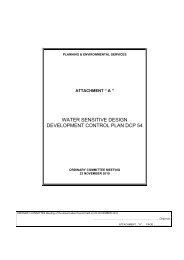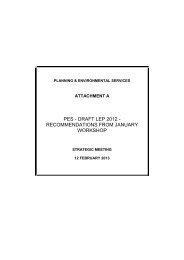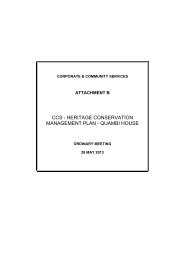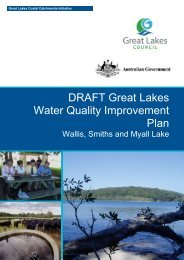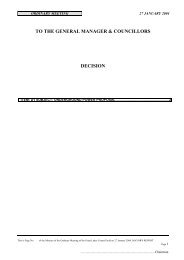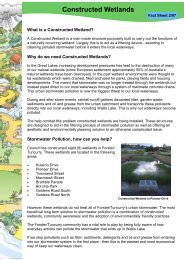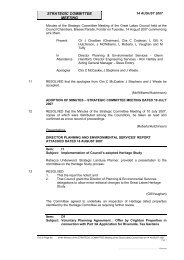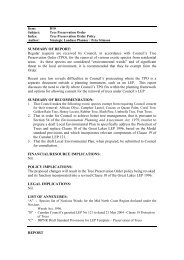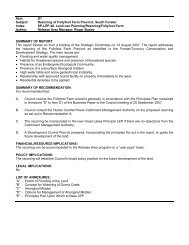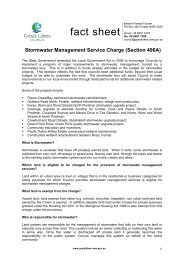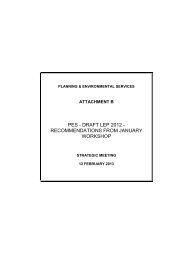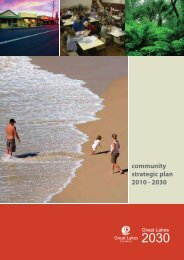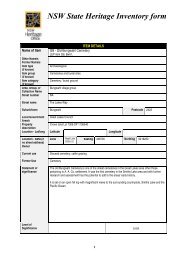Sediment and Hydrodynamic Assessment of the Lower Myall River ...
Sediment and Hydrodynamic Assessment of the Lower Myall River ...
Sediment and Hydrodynamic Assessment of the Lower Myall River ...
Create successful ePaper yourself
Turn your PDF publications into a flip-book with our unique Google optimized e-Paper software.
A part <strong>of</strong> BMT in Energy <strong>and</strong> Environment<br />
<strong>Sediment</strong> <strong>and</strong> <strong>Hydrodynamic</strong> <strong>Assessment</strong><br />
<strong>of</strong> <strong>the</strong> <strong>Lower</strong> <strong>Myall</strong> <strong>River</strong> Estuary <strong>and</strong><br />
Preparation <strong>of</strong> Management Recommendations<br />
Final Report<br />
September 2011
DOCUMENT CONTROL SHEET<br />
BMT WBM Pty Ltd<br />
BMT WBM Pty Ltd<br />
126 Belford Street<br />
BROADMEADOW NSW 2292<br />
Australia<br />
PO Box 266<br />
Broadmeadow NSW 2292<br />
Tel: +61 2 4940 8882<br />
Fax: +61 2 4940 8887<br />
ABN 54 010 830 421 003<br />
www.wbmpl.com.au<br />
Document :<br />
Project Manager :<br />
Client :<br />
Client Contact:<br />
Client Reference<br />
R.N1926.001.03.docx<br />
David Wainwright<br />
Great Lakes Council<br />
Gerard Tuckerman<br />
Contract No: 23/10 NS-SED-HYD-<br />
MYALLRIV<br />
Title :<br />
Author :<br />
Synopsis :<br />
<strong>Sediment</strong> <strong>Hydrodynamic</strong> <strong>Assessment</strong> <strong>of</strong> <strong>the</strong> <strong>Lower</strong> <strong>Myall</strong> <strong>River</strong> Estuary <strong>and</strong><br />
Preparation <strong>of</strong> Management Recommendations<br />
David Wainwright, Dr Emma Gale, Dr Philip Haines, Luke Kidd<br />
A study report detailing an assessment <strong>of</strong> hydrodynamics <strong>and</strong> morphology <strong>of</strong> <strong>the</strong><br />
<strong>Lower</strong> <strong>Myall</strong> <strong>River</strong>. The first part <strong>of</strong> <strong>the</strong> study identifies management issues through<br />
background data review, data analysis <strong>and</strong> community consultation. The study <strong>the</strong>n<br />
involved development <strong>of</strong> hydrodynamic <strong>and</strong> morphodynamic numerical models <strong>of</strong> <strong>the</strong><br />
<strong>Lower</strong> <strong>Myall</strong> <strong>River</strong> <strong>and</strong> entrance areas. Options for improving <strong>the</strong> condition <strong>of</strong> <strong>the</strong> river<br />
entrance were developed <strong>and</strong> were evaluated using <strong>the</strong> numerical models.<br />
REVISION/CHECKING HISTORY<br />
REVISION<br />
DATE OF ISSUE CHECKED BY ISSUED BY<br />
NUMBER<br />
0- Draft (Data Review) 19/10/10 DJW DJW<br />
2 – Second Draft<br />
3 - final<br />
4/03/11<br />
29/9/11<br />
PEH<br />
PEH<br />
DJW<br />
PEH<br />
DISTRIBUTION<br />
Great Lakes Council<br />
BMT WBM File<br />
BMT WBM Library<br />
DESTINATION<br />
REVISION<br />
0 2 3 4<br />
1-Electronic<br />
1-Electronic<br />
1-Electronic<br />
1-Electronic<br />
1-Electronic<br />
1-Electronic<br />
K:\N1926_LOWER_MYALL_RIVER_SEDIMENT_HYRODYNAMIC_ASSESSMENT\DOCS\R.N1926.001.03.DOCX
EXECUTIVE SUMMARY<br />
I<br />
EXECUTIVE SUMMARY<br />
The entrance <strong>of</strong> <strong>the</strong> <strong>Lower</strong> <strong>Myall</strong><br />
<strong>River</strong> is highly dynamic. Ocean storms,<br />
swell waves, wind waves, tides <strong>and</strong> catchment<br />
run<strong>of</strong>f all contribute to regular changes in s<strong>and</strong><br />
shoals <strong>and</strong> channels in <strong>and</strong> around <strong>the</strong> entrance<br />
area. Navigation through <strong>the</strong> entrance has been<br />
maintained by periodic <strong>and</strong> selective dredging <strong>of</strong><br />
<strong>the</strong> Nor<strong>the</strong>rn Channel, behind Corrie Isl<strong>and</strong>. The<br />
Eastern Channel, however, has not been dredged<br />
in recent years, <strong>and</strong> has progressively shoaled,<br />
particularly over <strong>the</strong> past 10 years or so.<br />
This report investigates <strong>the</strong> shoaling <strong>of</strong> <strong>the</strong> Eastern<br />
Channel; its causes, its ramifications; <strong>and</strong> possible<br />
options for manipulation. A companion<br />
investigation, undertaken by DECCW in 2010, has<br />
explored <strong>the</strong> current ecological health <strong>and</strong> water<br />
quality <strong>of</strong> <strong>the</strong> <strong>Lower</strong> <strong>Myall</strong> <strong>River</strong>.<br />
Recent shoaling <strong>of</strong> <strong>the</strong> Eastern Channel is linked to<br />
acute erosion <strong>of</strong> <strong>the</strong> Winda Woppa shoreline west<br />
<strong>of</strong> Barnes Rock, where a small wetl<strong>and</strong> is now<br />
under threat. In this location, ocean waves have<br />
eroded <strong>the</strong> shoreline <strong>and</strong> are pushing s<strong>and</strong><br />
westward toward <strong>the</strong> Eastern Channel (i.e.<br />
longshore drift). Analysis <strong>of</strong> beach data suggests<br />
that <strong>the</strong> shoaling in <strong>the</strong> Eastern<br />
Channel is unlikely to be linked to<br />
erosion on Jimmy’s Beach, to <strong>the</strong> east <strong>of</strong><br />
Barnes Rock.<br />
Gauging <strong>and</strong> hydrodynamic modelling indicate that<br />
as <strong>the</strong> Eastern Channel has become constricted,<br />
more tidal flows are directed through <strong>the</strong> Nor<strong>the</strong>rn<br />
(Back) Channel. Total tidal flows <strong>and</strong> levels<br />
upstream <strong>of</strong> <strong>the</strong> confluence <strong>of</strong> <strong>the</strong> two channels<br />
remains unchanged. What has changed, however,<br />
is <strong>the</strong> effectiveness <strong>of</strong> oceanic flushing within <strong>the</strong><br />
lower reaches <strong>of</strong> <strong>the</strong> <strong>River</strong>. The Nor<strong>the</strong>rn Channel<br />
is connected to Pindimar Bay some distance from<br />
<strong>the</strong> ocean, whereas <strong>the</strong> Eastern Channel is<br />
connected directly to <strong>the</strong> expansive Port Stephens<br />
flood tide delta. Therefore, water exchanged<br />
through <strong>the</strong> Eastern Channel is typically ‘clean’<br />
seawater, whereas water exchanged through <strong>the</strong><br />
Nor<strong>the</strong>rn Channel is ‘residual’ Port Stephens water.<br />
The DECCW (2010) study showed that Pindimar<br />
Bay <strong>and</strong> <strong>the</strong> <strong>Lower</strong> <strong>Myall</strong> <strong>River</strong> do not have poor<br />
water quality. Indeed <strong>the</strong> water quality is typical <strong>of</strong><br />
estuarine environments, while <strong>the</strong> ecological health<br />
is considered very good, <strong>and</strong> comparable to o<strong>the</strong>r<br />
nearby estuarine locations in Port Stephens. The<br />
recent constriction <strong>of</strong> <strong>the</strong> Eastern<br />
Channel <strong>the</strong>refore has not manifest<br />
in wider environmental impacts<br />
within <strong>the</strong> <strong>River</strong> to date.<br />
The shift in tidal flow preference from <strong>the</strong> Eastern<br />
Channel to <strong>the</strong> Nor<strong>the</strong>rn Channel may, however,<br />
help to explain <strong>the</strong> perception <strong>of</strong> reduced water<br />
clarity <strong>and</strong> salinity within <strong>the</strong> <strong>River</strong>, which has been<br />
reported anecdotally over <strong>the</strong> past few years.<br />
Flushing analysis suggests that when <strong>the</strong> Eastern<br />
Channel dominates tidal exchange, environmental<br />
conditions in <strong>the</strong> lower <strong>Myall</strong> <strong>River</strong> would tend to be<br />
more oceanic/marine, whereas when <strong>the</strong> Nor<strong>the</strong>rn<br />
Channel dominates, <strong>the</strong> conditions would tend to<br />
be more estuarine/brackish. Given <strong>the</strong> recent<br />
shoaling <strong>and</strong> associated shoreline erosion, it is<br />
conceivable that <strong>the</strong> Eastern Channel may<br />
eventually close completely. The timeframe for this<br />
to occur is unknown, <strong>and</strong> it may also require a<br />
catalyst, such as a large coastal storm. If <strong>and</strong><br />
when <strong>the</strong> channel does close, it is<br />
likely that <strong>the</strong> <strong>Lower</strong> <strong>Myall</strong> <strong>River</strong> will<br />
become more estuarine (given 100% <strong>of</strong><br />
tidal flows through <strong>the</strong> Nor<strong>the</strong>rn Channel). Subject<br />
to fur<strong>the</strong>r assessment, it is considered unlikely that<br />
complete closure <strong>of</strong> <strong>the</strong> Eastern Channel would<br />
have a detrimental impact on ecosystem health,<br />
although it may become less preferable for more<br />
marine-dependent species. There may also be a<br />
change to <strong>the</strong> aes<strong>the</strong>tics <strong>and</strong> amenity <strong>of</strong> <strong>the</strong> <strong>River</strong>,<br />
with a possible reduction in water clarity <strong>and</strong><br />
effectiveness <strong>of</strong> seawater exchange.<br />
K:\N1926_LOWER_MYALL_RIVER_SEDIMENT_HYRODYNAMIC_ASSESSMENT\DOCS\R.N1926.001.03.DOCX
EXECUTIVE SUMMARY<br />
II<br />
Works within <strong>the</strong> Eastern Channel would be<br />
required to reduce <strong>the</strong> likelihood <strong>of</strong> complete<br />
closure, or to re-open <strong>the</strong> channel once closed.<br />
Depending on <strong>the</strong> scale <strong>of</strong> <strong>the</strong>se works, seawater<br />
exchange could actually be increased within <strong>the</strong><br />
river compared to existing conditions. But<br />
ultimately, such channel works would only primarily<br />
address aes<strong>the</strong>tics <strong>and</strong> amenity, through an<br />
increase in water clarity <strong>and</strong> seawater exchange.<br />
There is currently no over-arching<br />
environmental justification for<br />
undertaking channel works. But<br />
conditions should continue to be monitored closely<br />
in <strong>the</strong> future as <strong>the</strong> channel approaches closure.<br />
Any decision to undertake intervention works in <strong>the</strong><br />
Eastern Channel would need to consider all<br />
benefits <strong>and</strong> costs, as well as <strong>the</strong> perspectives <strong>of</strong><br />
all potential stakeholders, including <strong>the</strong> community.<br />
Works in <strong>the</strong> Eastern Channel would essentially<br />
involve dredging. There is an opportunity<br />
for dredging <strong>of</strong> <strong>the</strong> Eastern Channel<br />
to be used as a source for future<br />
s<strong>and</strong> nourishment <strong>of</strong> Jimmy Beach.<br />
Recent nourishment works at Jimmys Beach have<br />
involved extraction <strong>of</strong> s<strong>and</strong> from <strong>the</strong> nearshore<br />
zone in an area near Yacaaba Headl<strong>and</strong>. It is<br />
understood that <strong>the</strong> Yacaaba source may not be<br />
able to meet on-going nourishment dem<strong>and</strong>s in <strong>the</strong><br />
future. The Eastern Channel <strong>the</strong>refore could be<br />
considered as an alternative or additional source<br />
for nourishment, subject to fur<strong>the</strong>r investigations.<br />
Any dredging program within <strong>the</strong> Eastern Channel<br />
would need to consider how quickly s<strong>and</strong> would refill<br />
<strong>the</strong> channel, <strong>and</strong> how <strong>of</strong>ten follow-up dredging<br />
may be required (if <strong>the</strong> channel is to remain open).<br />
Based on estimates <strong>of</strong> longshore drift, <strong>the</strong> channel<br />
would continue to infill at a rate <strong>of</strong> between 10,000<br />
<strong>and</strong> 20,000m 3 per year. This rate could be<br />
reduced through <strong>the</strong> construction <strong>of</strong> a groyne at <strong>the</strong><br />
western end <strong>of</strong> Winda Woppa Spit. A groyne<br />
would trap s<strong>and</strong> that continues to be eroded from<br />
<strong>the</strong> shoreline west <strong>of</strong> Barnes Rock <strong>and</strong> would help<br />
to maintain an open channel. The fillet <strong>of</strong> s<strong>and</strong> that<br />
builds in front <strong>of</strong> <strong>the</strong> groyne could also be used as<br />
a l<strong>and</strong>-based source <strong>of</strong> s<strong>and</strong> for on-going<br />
nourishment.<br />
If a groyne is not built, s<strong>and</strong> would need to be<br />
extracted subaqueously from <strong>the</strong> channel. This<br />
could be done using a mobile dredger as part <strong>of</strong><br />
discrete dredging campaigns, or by using fixed-inplace<br />
infrastructure (such as a S<strong>and</strong> Shifter<br />
device), where s<strong>and</strong> is fluidized, sucked into buried<br />
inlets <strong>and</strong> pumped ashore (this is currently done in<br />
<strong>the</strong> Noosa <strong>River</strong> <strong>and</strong> o<strong>the</strong>r locations for continuous<br />
nourishment <strong>of</strong> adjacent beaches).<br />
Given that s<strong>and</strong> moving into <strong>the</strong> Eastern Channel is<br />
primarily <strong>the</strong> result <strong>of</strong> shoreline recession west <strong>of</strong><br />
Barnes Rock, <strong>the</strong>re may also be a need to return<br />
some s<strong>and</strong> to <strong>the</strong> eroded beach pr<strong>of</strong>ile, particularly<br />
if access to <strong>the</strong> end <strong>of</strong> Winda Woppa Spit is to be<br />
maintained or <strong>the</strong> currently eroding wetl<strong>and</strong> is to be<br />
protected. Excess s<strong>and</strong> removed from <strong>the</strong> channel<br />
by capital dredging could be stockpiled locally (e.g.<br />
at <strong>the</strong> end <strong>of</strong> Winda Woppa Spit) <strong>and</strong> used for<br />
nourishment as needed.<br />
Initial capital dredging <strong>of</strong> <strong>the</strong> Eastern<br />
Channel would likely cost in <strong>the</strong><br />
order <strong>of</strong> $1.5 – 2.5 million, depending on<br />
<strong>the</strong> volume <strong>of</strong> s<strong>and</strong> removed (volumes <strong>of</strong> 55,000m 3<br />
<strong>and</strong> 95,000m 3 have been investigated to date).<br />
The establishment <strong>of</strong> fixed-in-place infrastructure<br />
for permanent s<strong>and</strong> pumping from <strong>the</strong> channel<br />
would cost less than $1 million, with on-going<br />
pumping costs <strong>of</strong> approximately $150,000 per<br />
annum (delivering s<strong>and</strong> to Jimmys Beach at a rate<br />
<strong>of</strong> about 15,000m 3 per year).<br />
By comparison, approximately $1 million<br />
has been spent recently by Council<br />
<strong>and</strong> State Government nourishing<br />
Jimmy’s Beach (total volume approximately<br />
80,000m 3 ) as part <strong>of</strong> a 3 year nourishment trial<br />
(Jelliffe Consultants, 2003). Some 372,000m 3 <strong>of</strong><br />
s<strong>and</strong> was previously (1984-1998) placed on<br />
Jimmy’s Beach to mitigate erosion risks (Watson,<br />
2000), giving an average beach nourishment <strong>of</strong><br />
about 17,000m 3 per year over <strong>the</strong> past 25 years.<br />
K:\N1926_LOWER_MYALL_RIVER_SEDIMENT_HYRODYNAMIC_ASSESSMENT\DOCS\R.N1926.001.03.DOCX
EXECUTIVE SUMMARY<br />
III<br />
Background <strong>and</strong> History<br />
The area <strong>of</strong> Port Stephens in <strong>the</strong> vicinity <strong>of</strong> <strong>the</strong><br />
Eastern Channel (known locally as “Paddy Mars<br />
Bar”) is ever-changing. The dynamism <strong>of</strong> <strong>the</strong> area<br />
is highlighted by <strong>the</strong> fact that <strong>Myall</strong> Point, a<br />
previous 2km long finger <strong>of</strong> s<strong>and</strong> extending south<br />
from <strong>the</strong> end <strong>of</strong> Winda Woppa, was completely<br />
destroyed during coastal storms in 1927 <strong>and</strong> 1929.<br />
Dredging <strong>of</strong> a navigable channel north <strong>of</strong> Corrie<br />
Isl<strong>and</strong>, dating back to <strong>the</strong> early 1900s, has also<br />
affected <strong>the</strong> pattern <strong>and</strong> distribution <strong>of</strong> tides <strong>and</strong><br />
flood flows into <strong>and</strong> out <strong>of</strong> <strong>the</strong> <strong>Lower</strong> <strong>Myall</strong> <strong>River</strong>.<br />
For <strong>the</strong> area west <strong>of</strong> Barnes Rock, coastal<br />
processes are continuing to push s<strong>and</strong> westward<br />
along Winda Woppa Spit. This s<strong>and</strong> has<br />
encroached into <strong>the</strong> Eastern Channel, which has<br />
responded by migrating westward <strong>and</strong> eroding <strong>the</strong><br />
eastern shore <strong>of</strong> Corrie Isl<strong>and</strong>. Over <strong>the</strong> past<br />
50 years, Corrie Isl<strong>and</strong> has receded<br />
by more than 100 metres. The rock wall<br />
in <strong>the</strong> Eastern Channel used to be <strong>the</strong> western<br />
(Corrie Isl<strong>and</strong>) edge <strong>of</strong> <strong>the</strong> channel - it now forms<br />
<strong>the</strong> eastern edge <strong>of</strong> <strong>the</strong> channel.<br />
Consultation <strong>and</strong> Community Perspectives<br />
Although <strong>the</strong> Eastern Channel has always been<br />
dynamic, it has become increasingly shoaled since<br />
about 2001. Local community members<br />
have raised concerns with all levels<br />
<strong>of</strong> Government regarding a perceived<br />
reduction in water clarity <strong>and</strong> water quality within<br />
<strong>the</strong> <strong>Lower</strong> <strong>Myall</strong> <strong>River</strong>.<br />
As part <strong>of</strong> this project, a series <strong>of</strong> workshops were<br />
held with <strong>the</strong> <strong>Myall</strong> <strong>River</strong> Action Group (MRAG) to<br />
ga<strong>the</strong>r local perspectives. The first workshop<br />
involved clarification <strong>of</strong> <strong>the</strong> key community issues<br />
associated with <strong>Lower</strong> <strong>Myall</strong> <strong>River</strong>. At this<br />
workshop, <strong>the</strong> MRAG highlighted several areas <strong>of</strong><br />
erosion <strong>and</strong> sedimentation as well as concern for<br />
reducing water clarity <strong>and</strong> water quality within <strong>the</strong><br />
river, <strong>and</strong> in Pindimar Bay. As outlined above, <strong>the</strong><br />
DECCW (2010) study showed that water quality<br />
<strong>and</strong> ecological health in <strong>the</strong> <strong>Lower</strong> <strong>Myall</strong> <strong>River</strong> <strong>and</strong><br />
Pindimar Bay are typical <strong>of</strong> estuarine systems.<br />
Areas <strong>of</strong> erosion <strong>and</strong> accretion raised by <strong>the</strong><br />
MRAG included:<br />
Erosion <strong>of</strong> Corrie Isl<strong>and</strong> eastern shore;<br />
Erosion west <strong>of</strong> Barnes Rock into<br />
protected wetl<strong>and</strong>s;<br />
Accretion along <strong>the</strong> edges <strong>of</strong> <strong>the</strong> Nor<strong>the</strong>rn<br />
Channel;<br />
Accretion within <strong>the</strong> <strong>Lower</strong> <strong>Myall</strong> <strong>River</strong><br />
main channel;<br />
Accretion in <strong>the</strong> vicinity <strong>of</strong> Singing Bridge.<br />
The second workshop was carried out following<br />
background investigations <strong>and</strong> preliminary<br />
modelling <strong>of</strong> tides <strong>and</strong> oceanic flushing. The<br />
workshop put <strong>the</strong> previous MRAG issues into a<br />
scientific context, <strong>and</strong> helped explain why particular<br />
processes are occurring.<br />
The third workshop was aimed at identifying a<br />
range <strong>of</strong> potential options that could address <strong>the</strong><br />
initial issues <strong>of</strong> concern. The options were<br />
developed taking into consideration <strong>the</strong> science<br />
behind <strong>the</strong> issues, <strong>and</strong> practicalities <strong>of</strong><br />
implementation <strong>and</strong> feasibility <strong>of</strong> outcomes.<br />
Although tabled initially, a number <strong>of</strong> gr<strong>and</strong>-scale<br />
options like rebuilding <strong>Myall</strong> Point were rejected as<br />
impractical during <strong>the</strong> workshop.<br />
It is envisaged that <strong>the</strong>re may be a<br />
range <strong>of</strong> alternative community<br />
views on this topic, <strong>and</strong> wider community<br />
engagement is proposed through <strong>the</strong> public<br />
exhibition <strong>of</strong> this document.<br />
Evaluation <strong>of</strong> Intervention Options<br />
The ecological health <strong>of</strong> <strong>the</strong> <strong>Lower</strong> <strong>Myall</strong> <strong>River</strong> is<br />
currently not compromised by <strong>the</strong> shoaled<br />
condition <strong>of</strong> <strong>the</strong> Eastern Channel. Intervention<br />
options for <strong>the</strong> Eastern Channel were <strong>the</strong>refore<br />
evaluated on <strong>the</strong> basis <strong>of</strong> improvements to<br />
aes<strong>the</strong>tics <strong>and</strong> amenity <strong>of</strong> <strong>the</strong> river, which<br />
fundamentally were <strong>the</strong> concerns <strong>of</strong> <strong>the</strong> MRAG.<br />
K:\N1926_LOWER_MYALL_RIVER_SEDIMENT_HYRODYNAMIC_ASSESSMENT\DOCS\R.N1926.001.03.DOCX
EXECUTIVE SUMMARY<br />
IV<br />
Options that were initially considered to have<br />
excessively high capital costs (e.g. a fully trained<br />
entrance or rebuilding <strong>Myall</strong> Point) or unacceptable<br />
environmental or social impacts (e.g. infilling <strong>of</strong> <strong>the</strong><br />
Nor<strong>the</strong>rn Channel) were excluded from detailed<br />
analysis. Remaining intervention options focused<br />
on dredging within <strong>the</strong> Eastern Channel, with <strong>and</strong><br />
without a groyne at <strong>the</strong> end <strong>of</strong> Winda Woppa spit,<br />
which could potentially improve <strong>the</strong> longevity <strong>of</strong> a<br />
dredged channel.<br />
As part <strong>of</strong> <strong>the</strong> evaluation process, consideration<br />
was given to <strong>the</strong> ‘do nothing’ option. For this<br />
option, it was assumed that <strong>the</strong> Eastern Channel<br />
was completely closed. In <strong>the</strong> absence <strong>of</strong> any<br />
intervention works, <strong>the</strong>re is a reasonable likelihood<br />
that <strong>the</strong> channel would eventually close (although<br />
<strong>the</strong> timeframe for this to occur is unknown).<br />
Computer modelling <strong>of</strong> <strong>the</strong> options confirmed that<br />
dredging within <strong>the</strong> Eastern Channel would<br />
increase tidal flows through <strong>the</strong> Eastern Channel,<br />
while reducing tidal flows through <strong>the</strong> Nor<strong>the</strong>rn<br />
Channel. The ratio <strong>of</strong> flows between <strong>the</strong> Eastern<br />
<strong>and</strong> Nor<strong>the</strong>rn Channels would return to about 3:1,<br />
which is comparable to <strong>the</strong> ratio measured in 1975<br />
(this compared to <strong>the</strong> most recent flow gauging in<br />
2009 when <strong>the</strong> ratio was approximately 1:1). Tidal<br />
flows upstream <strong>of</strong> <strong>the</strong> confluence would remain<br />
unchanged.<br />
The increased flow through <strong>the</strong><br />
Eastern Channel resulting from<br />
dredging would improve oceanic<br />
flushing in <strong>the</strong> lower reaches <strong>of</strong> <strong>the</strong><br />
<strong>River</strong>. This is because tides in <strong>the</strong> <strong>River</strong> would<br />
exchange more with ‘cleaner’ seawater nearer <strong>the</strong><br />
entrance to Port Stephens, <strong>and</strong> less with Pindimar<br />
Bay. There was no significant difference in flushing<br />
for <strong>the</strong> different dredging options modelled – all<br />
options gave a similar level <strong>of</strong> improvement.<br />
Analysis <strong>of</strong> longshore drift along <strong>the</strong> shoreline west<br />
<strong>of</strong> Barnes Rock was used to determine <strong>the</strong><br />
potential rates <strong>of</strong> infill for a dredged channel. A<br />
longshore drift rate <strong>of</strong> between 10,000 –<br />
15,000m 3 /yr has been calculated. For channel<br />
dredging <strong>of</strong> 55,000m 3 , approximately 50% <strong>of</strong> <strong>the</strong><br />
dredged material will return within about 3 years,<br />
while for dredging <strong>of</strong> 95,000m 3 , 50% infill would<br />
take roughly 5 years. A groyne at <strong>the</strong> end <strong>of</strong> Winda<br />
Woppa spit would improve <strong>the</strong> longevity <strong>of</strong><br />
dredging, but comes at a high capital cost given <strong>the</strong><br />
length <strong>of</strong> <strong>the</strong> structure required. A groyne would<br />
also be a very prominent ‘hard’ feature <strong>of</strong> <strong>the</strong><br />
l<strong>and</strong>scape, <strong>and</strong> its wider environmental <strong>and</strong> social<br />
impacts would require careful consideration.<br />
Within such a dynamic environment, it would be<br />
difficult to ensure that <strong>the</strong> groyne remains<br />
functional in <strong>the</strong> future.<br />
An alternative <strong>and</strong> possibly more pragmatic option<br />
may be a permanent s<strong>and</strong> pumping system, which<br />
can be modified <strong>and</strong> adjusted to suit specific<br />
requirements (including alternative disposal<br />
locations). This adaptable <strong>and</strong> flexible approach<br />
could also accommodate potential future variability<br />
associated with sea level rise <strong>and</strong> climate change<br />
impacts. It would require, however, an on-going<br />
financial commitment as part <strong>of</strong> a continuous<br />
maintenance program. This option would be<br />
particularly suited if s<strong>and</strong> pumped out <strong>of</strong> <strong>the</strong><br />
channel could be directed onto Jimmys Beach as<br />
part <strong>of</strong> a permanent nourishment solution.<br />
Placement <strong>of</strong> s<strong>and</strong> onto Jimmy’s Beach would<br />
need to be supported by an environmental<br />
assessment <strong>of</strong> <strong>the</strong> impacts <strong>of</strong> introducing ‘new’<br />
s<strong>and</strong> to this part <strong>of</strong> <strong>the</strong> shoreline.<br />
Benefit Cost Analysis<br />
Undertaking intervention works in <strong>the</strong> Eastern<br />
Channel would likely improve <strong>the</strong> aes<strong>the</strong>tics <strong>and</strong><br />
amenity <strong>of</strong> <strong>the</strong> <strong>River</strong> (through improved water<br />
clarity <strong>and</strong> oceanic flushing), but any wider benefits<br />
would be limited.<br />
When considering <strong>the</strong><br />
possible dual function <strong>of</strong> supplying<br />
s<strong>and</strong> for on-going nourishment <strong>of</strong><br />
Jimmys Beach, <strong>the</strong> benefit cost rate<br />
becomes more attractive. Indeed <strong>the</strong>re<br />
may only be a marginal cost difference, if any, for<br />
extracting nourishment s<strong>and</strong> from <strong>the</strong> Eastern<br />
Channel compared to <strong>the</strong> current reserve adjacent<br />
to Yacaaba Headl<strong>and</strong>, when considered over<br />
K:\N1926_LOWER_MYALL_RIVER_SEDIMENT_HYRODYNAMIC_ASSESSMENT\DOCS\R.N1926.001.03.DOCX
EXECUTIVE SUMMARY<br />
V<br />
longer time periods (i.e. 20 years +). Again, this<br />
assumes that <strong>the</strong>re would not be any detrimental<br />
impacts associated with using this s<strong>and</strong> on Jimmy’s<br />
Beach.<br />
Recommendation<br />
A s<strong>and</strong> scoping study is being considered that will<br />
investigate long-term management <strong>and</strong><br />
nourishment <strong>of</strong> Jimmys Beach (including s<strong>and</strong><br />
sourcing, delivery <strong>and</strong> placement). It is important<br />
that <strong>the</strong> option <strong>of</strong> sourcing s<strong>and</strong> from <strong>the</strong> Eastern<br />
Channel, ei<strong>the</strong>r via a permanent s<strong>and</strong> pumping<br />
system or discrete dredging campaigns, be<br />
included <strong>and</strong> evaluated in this context, as well as<br />
alternative s<strong>and</strong> sources such as <strong>the</strong> Yacaaba<br />
s<strong>and</strong> deposit that has been used for most recent<br />
nourishment works.<br />
The ecological impacts <strong>of</strong> erosion on <strong>the</strong> eastern<br />
shore <strong>of</strong> Corrie Isl<strong>and</strong> as well as <strong>the</strong> small wetl<strong>and</strong><br />
to <strong>the</strong> west <strong>of</strong> Barnes Rock should also be<br />
assessed, <strong>and</strong> an alternative management strategy<br />
be developed if dredging <strong>of</strong> <strong>the</strong> Eastern Channel is<br />
not to be pursued in <strong>the</strong> near future.<br />
If (<strong>and</strong> when) <strong>the</strong> Eastern Channel closes, <strong>the</strong><br />
ecosystem health <strong>of</strong> <strong>the</strong> <strong>Lower</strong> <strong>Myall</strong> <strong>River</strong> should<br />
be re-assessed to examine any wider<br />
environmental impacts <strong>of</strong> <strong>the</strong> channel closure.<br />
K:\N1926_LOWER_MYALL_RIVER_SEDIMENT_HYRODYNAMIC_ASSESSMENT\DOCS\R.N1926.001.03.DOCX
CONTENTS<br />
VI<br />
CONTENTS<br />
Executive Summary<br />
Contents<br />
List <strong>of</strong> Figures<br />
List <strong>of</strong> Tables<br />
i<br />
vi<br />
ix<br />
xi<br />
1 INTRODUCTION 1<br />
1.1 Study Area 1<br />
1.2 Detailed Study Area 5<br />
1.3 Objectives 5<br />
1.4 Methodology 5<br />
1.4.1 Identifying <strong>the</strong> Issues 6<br />
1.4.2 Validating <strong>the</strong> Issues 6<br />
1.4.3 Addressing <strong>the</strong> Issues 7<br />
2 IDENTIFYING THE ISSUES 8<br />
2.1 Existing Literature 8<br />
2.1.1 Paleo Geomorphology 8<br />
2.1.2 Recent Geomorphology 9<br />
2.1.3 Catchment Hydrology 14<br />
2.1.4 <strong>Hydrodynamic</strong>s 14<br />
2.1.4.1 Tides 14<br />
2.1.4.2 Salinity, Mixing <strong>and</strong> Flushing 15<br />
2.1.4.3 Waves 16<br />
2.1.5 <strong>Sediment</strong> Dynamics 16<br />
2.1.6 Estuarine Vegetation 16<br />
2.1.7 <strong>Assessment</strong> <strong>of</strong> Estuarine Health 17<br />
2.1.8 Existing Numerical Models 19<br />
2.1.8.1 <strong>Myall</strong> Lakes <strong>and</strong> <strong>Lower</strong> <strong>Myall</strong> <strong>River</strong> Numerical Model (2008) 19<br />
2.1.8.2 <strong>Lower</strong> <strong>Myall</strong> <strong>River</strong> Numerical Model (1980) 19<br />
2.1.8.3 University <strong>of</strong> Sydney, School <strong>of</strong> Geosciences Model 19<br />
2.1.8.4 Model Described in Watson (2000) 19<br />
2.2 Community Perspectives 20<br />
2.2.1 Perception <strong>of</strong> Existing Problems 20<br />
K:\N1926_LOWER_MYALL_RIVER_SEDIMENT_HYRODYNAMIC_ASSESSMENT\DOCS\R.N1926.001.03.DOCX
CONTENTS<br />
VII<br />
2.2.1.1 Poor Water Quality in <strong>the</strong> <strong>Lower</strong> <strong>Myall</strong> <strong>River</strong> 20<br />
2.2.1.2 S<strong>and</strong> Nourishment at Jimmys Beach 21<br />
2.2.1.3 Loss <strong>of</strong> <strong>the</strong> <strong>Myall</strong> Spit 21<br />
2.2.1.4 S<strong>and</strong> Accumulation along <strong>the</strong> <strong>River</strong> 21<br />
2.2.1.5 Connection <strong>of</strong> Corrie Isl<strong>and</strong> to <strong>the</strong> Mainl<strong>and</strong> 21<br />
2.2.2 Initial Community Suggestions for Potential Solutions 23<br />
2.2.2.1 Poor Water Quality in <strong>the</strong> <strong>Lower</strong> <strong>Myall</strong> <strong>River</strong> 23<br />
2.2.2.2 S<strong>and</strong> Nourishment at Jimmys Beach 23<br />
2.2.2.3 Loss <strong>of</strong> <strong>the</strong> <strong>Myall</strong> Spit 24<br />
2.2.2.4 S<strong>and</strong> Accumulation along <strong>the</strong> <strong>River</strong> 24<br />
2.2.2.5 Connection <strong>of</strong> Corrie Isl<strong>and</strong> to <strong>the</strong> Mainl<strong>and</strong> 24<br />
2.3 Summary <strong>of</strong> Issues <strong>and</strong> Likely Causes 24<br />
3 AVAILABLE DATA AND ANALYSIS 26<br />
3.1 Bathymetric Data 26<br />
3.1.1 Existing Information 26<br />
3.1.2 Historical Features <strong>and</strong> Trends 27<br />
3.1.3 Recent Features <strong>and</strong> Trends 29<br />
3.2 Tidal Data 31<br />
3.2.1 Tidal Data Collection Campaigns 31<br />
3.2.2 Tidal Characteristics 32<br />
3.3 Wave Data 37<br />
3.3.1 Swell Waves 37<br />
3.3.2 Wind Waves 42<br />
3.3.3 Boat Wake 43<br />
3.4 Aerial Photography 44<br />
3.4.1 Existing information 44<br />
3.4.2 Analysis 44<br />
3.5 Photogrammetry 48<br />
3.6 <strong>Sediment</strong>s 48<br />
3.7 Source <strong>of</strong> S<strong>and</strong> Accumulation in <strong>the</strong> Eastern Channel 53<br />
3.8 Summary 53<br />
4 COMPUTER MODEL DEVELOPMENT 54<br />
4.1 Scope <strong>and</strong> Objectives 54<br />
4.2 Model Establishment 54<br />
4.3 Calibrating <strong>and</strong> Evaluating <strong>the</strong> Model 58<br />
4.3.1 Availability <strong>of</strong> data 58<br />
K:\N1926_LOWER_MYALL_RIVER_SEDIMENT_HYRODYNAMIC_ASSESSMENT\DOCS\R.N1926.001.03.DOCX
CONTENTS<br />
VIII<br />
4.3.2 Gauging locations 58<br />
4.3.3 Approach to model calibration 58<br />
4.3.4 Results <strong>of</strong> <strong>Hydrodynamic</strong> Calibration 58<br />
4.3.4.1 Flow 59<br />
4.3.4.2 Water level 63<br />
4.3.5 Results <strong>of</strong> Mixing <strong>and</strong> Transport (Salinity) Calibration 66<br />
4.3.5.1 Approach to validation 66<br />
4.3.5.2 Results 66<br />
4.3.6 Performance <strong>of</strong> <strong>the</strong> Morphodynamic Model 70<br />
4.3.6.1 Approach to <strong>Assessment</strong> 70<br />
4.3.6.2 Results 71<br />
5 ANALYSIS OF OPTIONS AND ALTERNATIVES 74<br />
5.1 Processes / Issues to be Addressed 74<br />
5.2 Do Nothing 74<br />
5.3 Development <strong>of</strong> Options 75<br />
5.3.1 Dredging <strong>of</strong> <strong>the</strong> Eastern Channel <strong>and</strong> Winda Woppa Spit 75<br />
5.3.2 Disposal <strong>of</strong> Dredged <strong>Sediment</strong>s 76<br />
5.3.3 Permanent S<strong>and</strong> Pumping System 76<br />
5.3.4 Western Groyne to Capture On-going Longshore <strong>Sediment</strong> Supply 79<br />
5.3.5 Flow Constriction in Nor<strong>the</strong>rn Channel 79<br />
5.3.6 Tombolo to Re-establish <strong>Myall</strong> Point 81<br />
5.3.7 New Alternative <strong>River</strong> Entrance 81<br />
5.4 Initial <strong>Assessment</strong> <strong>and</strong> Short-listing <strong>of</strong> Options 84<br />
5.5 Detailed <strong>Assessment</strong> <strong>of</strong> Short-listed Options 88<br />
5.5.1 Comparison Options 88<br />
5.5.2 Dredging Options 88<br />
5.5.3 Disposal Options 89<br />
5.5.4 Modelling Simulations 90<br />
5.5.5 Evaluation <strong>of</strong> Environmental Impacts 90<br />
5.5.5.1 Impacts on Flow Distribution 90<br />
5.5.5.2 Impacts on Oceanic Flushing 93<br />
5.5.5.3 Impacts on Salinity 93<br />
5.5.5.4 Impacts on Entrance Morphology 97<br />
5.5.5.5 Impacts on Longshore Drift 107<br />
5.5.5.6 Impacts on Aquatic Ecology 107<br />
5.5.5.7 Impacts on Terrestrial Ecology 108<br />
5.5.5.8 Impacts on Ecosystem Health <strong>and</strong> Community Structure 108<br />
5.5.5.9 O<strong>the</strong>r Considerations 108<br />
K:\N1926_LOWER_MYALL_RIVER_SEDIMENT_HYRODYNAMIC_ASSESSMENT\DOCS\R.N1926.001.03.DOCX
LIST OF FIGURES<br />
IX<br />
5.5.6 Evaluation <strong>of</strong> Longevity <strong>of</strong> Works 109<br />
5.5.7 Evaluation <strong>of</strong> Economic Impacts 110<br />
5.5.7.1 Benefits 110<br />
5.5.7.2 Capital Costs 111<br />
5.5.7.3 Maintenance Costs 111<br />
5.5.7.4 Total Cost Comparison 112<br />
5.5.8 Evaluation <strong>of</strong> Social Impacts 112<br />
5.6 Summary <strong>of</strong> Options <strong>Assessment</strong> 113<br />
5.7 Fur<strong>the</strong>r Considerations 116<br />
6 RECOMMENDED NEXT STEPS 117<br />
6.1 Overview 117<br />
6.2 Approvals <strong>and</strong> Consents 119<br />
7 REFERENCES 120<br />
APPENDIX A: HISTORICAL HYDROGRAPHIC SURVEYS SOURCE:WATSON,<br />
2008 A-1<br />
APPENDIX B: WIND AND WAVE DATA B-1<br />
APPENDIX C: SCENARIO SELECTION FOR MORPHOLOGICAL MODELLING C-1<br />
APPENDIX D: LONGSHORE SEDIMENT TRANSPORT CALCULATIONS D-1<br />
APPENDIX E: MODELLING SOFTWARE AND MODEL ESTABLISHMENT E-1<br />
LIST OF FIGURES<br />
Figure 1-1 Locality Plan 2<br />
Figure 1-2 Study Area 3<br />
Figure 1-3 Project Stages 6<br />
Figure 2-1 Depositional Areas Within Port Stephens (from Thom et al., 1992) 9<br />
Figure 2-2 Present Day Bathymetry <strong>of</strong> Port Stephens <strong>and</strong> <strong>the</strong> <strong>Lower</strong> <strong>Myall</strong> <strong>River</strong> 11<br />
Figure 2-3 Historical Development <strong>of</strong> <strong>the</strong> Study Area (from Thom et al, 1992) 12<br />
Figure 2-4<br />
C<strong>of</strong>fee Rock Eroding from Eastern Edge <strong>of</strong> Corrie Isl<strong>and</strong> (17/08/2010) (courtesy<br />
Martin Fitzhenry, DECCW)<br />
13<br />
Figure 2-5 Estuarine Vegetation <strong>and</strong> Park Boundaries 18<br />
Figure 2-6 Community Identified Problems 22<br />
K:\N1926_LOWER_MYALL_RIVER_SEDIMENT_HYRODYNAMIC_ASSESSMENT\DOCS\R.N1926.001.03.DOCX
LIST OF FIGURES<br />
X<br />
Figure 2-7 Newspaper Article on Corrie Isl<strong>and</strong> (Newcastle Herald, 25 th September 2010)<br />
23<br />
Figure 2-8 Interaction <strong>of</strong> Processes Leading to Perceived Problems 25<br />
Figure 3-1 Changes in <strong>the</strong> Study Region Bathymetry from 2001 to 2009 30<br />
Figure 3-2 Water Level, Flow <strong>and</strong> Salinity Measurement Sites 33<br />
Figure 3-3 Water levels within Port Stephens <strong>and</strong> <strong>the</strong> <strong>Myall</strong> Lakes, September 2009 (MHL)<br />
34<br />
Figure 3-4 Tidal Limits for Port Stephens 36<br />
Figure 3-5 Wave heights for Sydney <strong>and</strong> Crowdy Head for September 2009 40<br />
Figure 3-6 Offshore Wave Heights <strong>and</strong> Direction for Sydney, during September 2009 41<br />
Figure 3-7 Wave Height <strong>and</strong> Wave Period for Sydney during September, 2009 42<br />
Figure 3-8 Wind Speed <strong>and</strong> Direction for September 2009 43<br />
Figure 3-9 Wind Direction for September 2009 44<br />
Figure 3-10 Long Term <strong>Sediment</strong> Transport in <strong>the</strong> Study Area 45<br />
Figure 3-11 Decadal Trends Around <strong>the</strong> S<strong>and</strong> Spit <strong>and</strong> Eastern Shoreline <strong>of</strong> Corrie isl<strong>and</strong><br />
46<br />
Figure 3-12 Decadal Trends Around <strong>the</strong> Tip <strong>of</strong> Corrie Isl<strong>and</strong> 47<br />
Figure 3-13 Shoals, Shorelines <strong>and</strong> Spit Dynamics (DECCW 2009) 49<br />
Figure 3-14 <strong>Sediment</strong> Distributions in <strong>the</strong> <strong>Lower</strong> <strong>Myall</strong> <strong>River</strong> (MHL 1993) 51<br />
Figure 3-15 <strong>Sediment</strong> Sampling Sites for 1975 Study (MHL 1993) 52<br />
Figure 4-1 Numerical Models Adopted for <strong>the</strong> Investigations 54<br />
Figure 4-2 Combined <strong>Hydrodynamic</strong>, Wave <strong>and</strong> Morphological Modelling 55<br />
Figure 4-3 Model Mesh for Port Stephens <strong>and</strong> <strong>the</strong> <strong>Lower</strong> <strong>Myall</strong> <strong>River</strong> 56<br />
Figure 4-4 SWAN Model Grid Extents 57<br />
Figure 4-5 Flow Results for Nor<strong>the</strong>rn Channel 60<br />
Figure 4-6 Flow Results for <strong>the</strong> Eastern Channel 60<br />
Figure 4-7 Flow Results for Monkey Jacket 61<br />
Figure 4-8 Eastern Channel Flow Vectors (MHL 2009) 62<br />
Figure 4-9 Water Level Results at Pindimar Bay 63<br />
Figure 4-10 Water Level Results at <strong>the</strong> Confluence to Corrie Isl<strong>and</strong> 63<br />
Figure 4-11 Water Level Results Upstream <strong>of</strong> Monkey Jacket 64<br />
Figure 4-12 Water level Results at Brasswater 64<br />
Figure 4-13 Water Level Results at Mallabulla, Port Stephens 65<br />
Figure 4-14 Water Level Results at Bombah Point, <strong>Myall</strong> Lakes 65<br />
Figure 4-15 Salinity Results for Pindimar Bay 68<br />
Figure 4-16 Salinity Results for Corrie Isl<strong>and</strong> Confluence 68<br />
Figure 4-17 Salinity Results from Monkey Jacket 69<br />
Figure 4-18 Salinity Results from Brasswater 69<br />
Figure 4-19 Salinity Results for Bombah Point 70<br />
Figure 4-20 Morphological Patterns in <strong>the</strong> <strong>Lower</strong> <strong>Myall</strong> Region 73<br />
K:\N1926_LOWER_MYALL_RIVER_SEDIMENT_HYRODYNAMIC_ASSESSMENT\DOCS\R.N1926.001.03.DOCX
LIST OF TABLES<br />
XI<br />
Figure 5-1 S<strong>and</strong> shifter Permanent S<strong>and</strong> Pumping System (source: Slurry Systems<br />
Marine)<br />
77<br />
Figure 5-2 Preliminary Options: Dredging <strong>and</strong> Construction <strong>of</strong> Western Groyne 78<br />
Figure 5-3 Preliminary Options: Constrict Nor<strong>the</strong>rn Channel 80<br />
Figure 5-4 Preliminary Options: Re-establish <strong>Myall</strong> Point 82<br />
Figure 5-5 Preliminary Options: Alternative <strong>River</strong> Entrance 83<br />
Figure 5-6 Simulated Change to Tidal Flows 92<br />
Figure 5-7 Simulated Changes to Flushing With <strong>and</strong> Without Dredging 94<br />
Figure 5-8 Simulated Water Levels <strong>and</strong> Flows from <strong>Myall</strong> Lakes for Salinity Analysis95<br />
Figure 5-9 Simulated Changes to 24 hour Moving Average Salinity With <strong>and</strong> Without<br />
Dredging<br />
96<br />
Figure 5-10 Existing conditions – Morphological Changes over 1 Month 99<br />
Figure 5-11 Dredge option A – Morphological Changes over 1 Month 100<br />
Figure 5-12 Dredge Option B – Morphological Changes over 1 Month 101<br />
Figure 5-13 Dredge Option C - Morphological Changes over 1 Month 102<br />
Figure 5-14 Transect Location Map 103<br />
Figure 5-15 Changes to bed elevations at Transect 1 104<br />
Figure 5-16 Changes to Bed Elevations at Transect 2 104<br />
Figure 5-17 Changes to Bed Elevations at Transect 3 105<br />
Figure 5-18 Changes to Bed Elevations at Transect 4 105<br />
Figure 5-19 Simulated Morphological Changes at <strong>the</strong> End <strong>of</strong> <strong>the</strong> Nor<strong>the</strong>rn Channel106<br />
Figure 6-1 Recommended Decision Support Framework 118<br />
LIST OF TABLES<br />
Table 3-1 Evolution <strong>of</strong> Corrie Isl<strong>and</strong> 28<br />
Table 3-2 Evolution <strong>of</strong> <strong>Myall</strong> Point / Spit 28<br />
Table 3-3 Channel Dynamics surrounding Corrie Isl<strong>and</strong> 29<br />
Table 3-4 Tidal Planes <strong>and</strong> Tidal Ranges for Port Stephens (source: MHL, 2009) 34<br />
Table 3-5 Elevated Water Levels, Fort Denison, Sydney (WBM 2010) 35<br />
Table 3-6 Typical Maximum Tidal Velocities 37<br />
Table 3-7 Tidal Prisms (MHL, 2010) 37<br />
Table 3-8 Average Recurrence Interval Storm Wave Heights (derived from MHL, 2009)<br />
38<br />
Table 3-9 Percentage Joint Occurrence <strong>of</strong> Wave Height <strong>and</strong> Direction, Sydney (March<br />
1992 to December 2008, 16.84 years) 39<br />
Table 3-10 ARI Wind Speeds at Each Wind Octant 43<br />
Table 3-11 <strong>Sediment</strong> particle sizes for <strong>the</strong> <strong>Lower</strong> <strong>Myall</strong> <strong>River</strong> entrance (MHL 1993) 50<br />
Table 4-1 Bed Roughness Parameters Adopted 59<br />
Table 5-1 First Pass Qualitative Multi-Criteria <strong>Assessment</strong> <strong>of</strong> Options 85<br />
K:\N1926_LOWER_MYALL_RIVER_SEDIMENT_HYRODYNAMIC_ASSESSMENT\DOCS\R.N1926.001.03.DOCX
LIST OF TABLES<br />
XII<br />
Table 5-2 Summary <strong>of</strong> Model Scenarios 91<br />
Table 5-3 Approximate Longevity <strong>of</strong> Short-Listed Options to Reach 50% Infill <strong>of</strong> Dredging<br />
110<br />
Table 5-4 Approximate Capital Costs for Short-listed Options 111<br />
Table 5-5 Approximate Maintenance Costs for Short-listed Options 111<br />
Table 5-6 Total Costs Comparison after 10 Years <strong>and</strong> 20 Years (Present Dollar Value)<br />
113<br />
Table 5-7 Summary <strong>of</strong> Options <strong>Assessment</strong> 114<br />
Table 6-1 Relevance <strong>of</strong> Issues 117<br />
K:\N1926_LOWER_MYALL_RIVER_SEDIMENT_HYRODYNAMIC_ASSESSMENT\DOCS\R.N1926.001.03.DOCX
INTRODUCTION 1<br />
1 INTRODUCTION<br />
1.1 Study Area<br />
The Port Stephens / <strong>Myall</strong> Lakes estuary is located approximately 50km north <strong>of</strong> Newcastle, NSW.<br />
The <strong>Lower</strong> <strong>Myall</strong> <strong>River</strong> enters Port Stephens from <strong>the</strong> north, while <strong>the</strong> o<strong>the</strong>r major tributaries to <strong>the</strong><br />
estuary, <strong>the</strong> Karuah <strong>River</strong> <strong>and</strong> Tilligerry Creek, enter from <strong>the</strong> northwest <strong>and</strong> south, respectively<br />
(Figure 1-1).<br />
The <strong>Myall</strong> Lakes are located north <strong>of</strong> Port Stephens, connected via <strong>the</strong> <strong>Lower</strong> <strong>Myall</strong> <strong>River</strong>. The Lakes<br />
comprise a series <strong>of</strong> three interconnected lakes (Bombah Broadwater, Boolambayte Lake <strong>and</strong> <strong>Myall</strong><br />
Lake). The <strong>Lower</strong> <strong>Myall</strong> <strong>River</strong> is around 30 km long extending from Bombah Broadwater to Port<br />
Stephens. The <strong>River</strong> enters Port Stephens through a channel between Corrie Isl<strong>and</strong> <strong>and</strong> Winda<br />
Woppa spit (<strong>the</strong> eastern or “Shortcut” Channel), <strong>and</strong> also through a channel to <strong>the</strong> immediate north <strong>of</strong><br />
Corrie Isl<strong>and</strong> (<strong>the</strong> nor<strong>the</strong>rn or “Back” Channel) into Pindimar Bay (Figure 1-2).<br />
An extensive marine flood tide delta covering an area <strong>of</strong> some 22.5 km 2 extends across <strong>the</strong> entrance<br />
to Port Stephens <strong>and</strong> includes area adjacent to Winda Woppa <strong>and</strong> <strong>the</strong> Eastern Channel (Austin et al.,<br />
2009). This delta has been formed during <strong>the</strong> Holocene period by <strong>the</strong> complex interaction <strong>of</strong> tides,<br />
waves <strong>and</strong> minor flows from <strong>the</strong> <strong>Lower</strong> <strong>Myall</strong> <strong>River</strong>. The delta is shallow, typically less than 4 to 8<br />
metres below mean sea level. A steep dropover at <strong>the</strong> distal edge <strong>of</strong> <strong>the</strong> delta into deeper water<br />
extends roughly north-south from Corlette Head to <strong>the</strong> western side <strong>of</strong> Corrie Isl<strong>and</strong>. West <strong>of</strong> <strong>the</strong><br />
dropover, water depths increase to 20 metres (MHL, 1999).<br />
Interactions between tidal currents, swell waves, wind waves <strong>and</strong> occasional fluvial flows from <strong>the</strong><br />
<strong>Myall</strong> <strong>River</strong> continue to rework <strong>the</strong> s<strong>and</strong> shoals (e.g. Paddy Marrs Bar, Middle Ground), channels <strong>and</strong><br />
isl<strong>and</strong>s (e.g. Corrie Isl<strong>and</strong>) <strong>of</strong> <strong>the</strong> flood-tide delta <strong>and</strong> adjacent shorelines. Episodic erosion <strong>of</strong> <strong>the</strong><br />
eastern side <strong>of</strong> Corrie Isl<strong>and</strong> occurs during storms with large ocean waves. Tidal flows are also<br />
presently eroding <strong>the</strong> eastern side <strong>of</strong> Corrie Isl<strong>and</strong>.<br />
An estuarine beach complex extends 4.2 km westwards from Yacaaba Headl<strong>and</strong> to <strong>the</strong> <strong>Myall</strong> <strong>River</strong><br />
mouth, including <strong>the</strong> Yacaaba barrier, Jimmys Beach <strong>and</strong> Winda Woppa spit. Detailed investigations<br />
are ongoing <strong>and</strong> aim to better underst<strong>and</strong> morphologic changes <strong>of</strong> <strong>the</strong> flood-tide delta <strong>and</strong> <strong>the</strong>se<br />
adjacent estuarine beaches. A recent report by Vila-Concejo et al. (2008) concluded:<br />
<br />
<br />
<br />
a s<strong>and</strong> wave at Yacaaba Barrier has undergone various cycles <strong>of</strong> accretion <strong>and</strong> erosion, with<br />
westerly migration <strong>of</strong> up to 70 metres per year between 1993 to 2003 followed by relative<br />
stability, with occasional storm events (e.g. June 2007) allowing for accretion <strong>of</strong> <strong>the</strong> s<strong>and</strong> wave;<br />
Ongoing recession <strong>of</strong> Jimmy’s Beach, to <strong>the</strong> east <strong>of</strong> Barnes Rock, threatens a number <strong>of</strong><br />
residences along The Boulevard. Recession has occurred at an average rate <strong>of</strong> 1 metre per<br />
year between 1951 <strong>and</strong> 2006.<br />
The shoreline between <strong>the</strong> western end <strong>of</strong> <strong>the</strong> s<strong>and</strong> wave near Yacaaba headl<strong>and</strong> to <strong>the</strong><br />
recession area has been stable over <strong>the</strong> medium to long term; <strong>and</strong><br />
K:\N1926_LOWER_MYALL_RIVER_SEDIMENT_HYRODYNAMIC_ASSESSMENT\DOCS\R.N1926.001.03.DOCX
INTRODUCTION 2<br />
Figure 1-1<br />
Locality Plan<br />
K:\N1926_LOWER_MYALL_RIVER_SEDIMENT_HYRODYNAMIC_ASSESSMENT\DOCS\R.N1926.001.03.DOCX
INTRODUCTION 3<br />
Figure 1-2<br />
Study Area<br />
K:\N1926_LOWER_MYALL_RIVER_SEDIMENT_HYRODYNAMIC_ASSESSMENT\DOCS\R.N1926.001.03.DOCX
INTRODUCTION 4<br />
Winda Woppa spit is subject to ongoing retreat <strong>and</strong> westward extension (approximately 800<br />
metres since 1951).<br />
Earlier work by Vila-Concejo et al. (2007) also notes that sediment transport patterns inside <strong>the</strong> Port<br />
Stephens estuary are not clear <strong>and</strong> that future investigation should be undertaken, using a<br />
morphodynamic model to represent <strong>the</strong> key processes. To improve management <strong>of</strong> <strong>the</strong> system, Vila-<br />
Concejo et al. (2007) highlight that sediment exchanges need to be quantified to better underst<strong>and</strong><br />
<strong>and</strong> protect public <strong>and</strong> private assets.<br />
Historically, <strong>the</strong> main entrance to <strong>the</strong> <strong>Lower</strong> <strong>Myall</strong> <strong>River</strong> was <strong>the</strong> Eastern Channel between Corrie<br />
Isl<strong>and</strong> <strong>and</strong> Winda Woppa. Anecdotal evidence indicates that ships previously unloaded ballast rock<br />
within <strong>the</strong> channel prior to traversing <strong>the</strong> shallower depths to Tea Gardens (with <strong>the</strong> rock still evident<br />
today). The former <strong>Myall</strong> Point is claimed to have extended from <strong>the</strong> nor<strong>the</strong>rn foreshore to within<br />
approximately 100 metres <strong>of</strong> <strong>the</strong> sou<strong>the</strong>rn foreshore <strong>of</strong> <strong>the</strong> estuary (Umwelt, 2000), although<br />
historical mapping presented in Thom et al. (1992) suggests that this claim is unfounded, at least in<br />
contemporary times, with some 2.5km between <strong>the</strong> sou<strong>the</strong>rn tip <strong>of</strong> <strong>Myall</strong> Point <strong>and</strong> <strong>the</strong> Port Stephens<br />
sou<strong>the</strong>rn shoreline in 1920.<br />
<strong>Myall</strong> Point was still none<strong>the</strong>less an historical s<strong>and</strong> feature extending southwards from Winda Woppa,<br />
parallel to Corrie Isl<strong>and</strong> extending <strong>the</strong> <strong>Lower</strong> <strong>Myall</strong> <strong>River</strong> well into <strong>the</strong> Port Stephens waterway. <strong>Myall</strong><br />
Point was destroyed during severe storms in 1927 <strong>and</strong> 1929 (Umwelt, 2000). In addition, dredging to<br />
form <strong>the</strong> Nor<strong>the</strong>rn Channel is believed to have commenced around <strong>the</strong> turn <strong>of</strong> <strong>the</strong> 20 th century to<br />
assist with navigation between Pindimar Bay <strong>and</strong> Tea Gardens. Both <strong>the</strong>se events are reported to<br />
have initiated major changes to <strong>the</strong> entrance configuration <strong>of</strong> <strong>the</strong> <strong>Lower</strong> <strong>Myall</strong> <strong>River</strong> (MHL, 1999).<br />
The changes to <strong>the</strong> <strong>Lower</strong> <strong>Myall</strong> <strong>River</strong> entrance include shoaling <strong>of</strong> <strong>the</strong> Eastern Channel, which has<br />
now become less tidally dominant compared to <strong>the</strong> Nor<strong>the</strong>rn Channel. The Eastern Channel has<br />
become restricted to <strong>the</strong> point that access is only possible at high tide by experienced navigators.<br />
The Nor<strong>the</strong>rn Channel has become <strong>the</strong> main navigable entrance to <strong>the</strong> <strong>Lower</strong> <strong>Myall</strong> <strong>River</strong>.<br />
In <strong>the</strong> past, <strong>the</strong>re has been pressure to dredge <strong>the</strong> Eastern Channel between Corrie Isl<strong>and</strong> <strong>and</strong><br />
Winda Woppa spit, <strong>and</strong> subsequently use <strong>the</strong> dredged spoil to nourish Jimmys Beach. However,<br />
<strong>the</strong>re is doubt that river flow would be able to naturally maintain such a channel, thus necessitating<br />
on-going dredging <strong>of</strong> <strong>the</strong> channel (MHL, 1999).<br />
Shoaling <strong>of</strong> <strong>the</strong> Nor<strong>the</strong>rn Channel has also been an ongoing issue, causing additional problems for<br />
navigation into <strong>the</strong> <strong>Lower</strong> <strong>Myall</strong> <strong>River</strong>. It has been necessary to dredge this channel to maintain<br />
navigation, particularly for <strong>the</strong> larger boats – dredging has most recently been carried out in late 2010.<br />
The continued shoaling <strong>of</strong> both channels means that ongoing dredging has become a logistical <strong>and</strong><br />
financial issue for Council <strong>and</strong> <strong>the</strong> State Government. O<strong>the</strong>r issues associated with changes to<br />
entrance conditions include <strong>the</strong> cost <strong>of</strong> relocating navigational markers, risks to commercial <strong>and</strong><br />
recreational vessels as <strong>the</strong>y cross <strong>the</strong> shoals <strong>and</strong> potential loss <strong>of</strong> tourism into <strong>the</strong> Tea Gardens <strong>and</strong><br />
<strong>Myall</strong> <strong>River</strong> due to difficulties with navigation (Umwelt, 2000).<br />
K:\N1926_LOWER_MYALL_RIVER_SEDIMENT_HYRODYNAMIC_ASSESSMENT\DOCS\R.N1926.001.03.DOCX
INTRODUCTION 5<br />
1.2 Detailed Study Area<br />
The present study focuses on <strong>the</strong> <strong>Lower</strong> <strong>Myall</strong> <strong>River</strong> downstream <strong>of</strong> <strong>the</strong> Singing Bridge (between Tea<br />
Gardens <strong>and</strong> Hawks Nest) <strong>and</strong> its entrance into Port Stephens (refer Figure 1-2). It includes <strong>the</strong><br />
Nor<strong>the</strong>rn (Back) Channel, <strong>the</strong> Eastern (Shortcut) Channel, Corrie Isl<strong>and</strong>, <strong>and</strong> Winda Woppa Spit to<br />
<strong>the</strong> west <strong>of</strong> Barnes Rock.<br />
The issues <strong>of</strong> concern within <strong>the</strong> focus area are influenced by coastal <strong>and</strong> estuarine processes in<br />
adjacent areas, such as <strong>the</strong> <strong>Lower</strong> <strong>Myall</strong> <strong>River</strong> upstream <strong>of</strong> <strong>the</strong> Singing Bridge, Jimmy’s Beach to <strong>the</strong><br />
west <strong>of</strong> Barnes Rock <strong>and</strong> <strong>the</strong> broader flood tidal delta which occupies much <strong>of</strong> Port Stephens to <strong>the</strong><br />
east <strong>and</strong> south <strong>of</strong> Corrie Isl<strong>and</strong>. In turn, processes <strong>and</strong> morphodynamic responses in those areas are<br />
influenced by hydrodynamics <strong>and</strong> wave processes in Port Stephens, <strong>the</strong> <strong>Myall</strong> Lakes <strong>and</strong> <strong>the</strong> ocean<br />
beyond Yacaaba <strong>and</strong> Tomaree Headl<strong>and</strong>s.<br />
While <strong>the</strong> issues <strong>of</strong> concern to this study apply to <strong>the</strong> detailed investigation area, <strong>the</strong> broader<br />
processes affecting those issues have been considered where appropriate.<br />
1.3 Objectives<br />
The objectives <strong>of</strong> this study are:<br />
<br />
<br />
<br />
<br />
To undertake a sediment <strong>and</strong> hydrodynamics assessment <strong>of</strong> <strong>the</strong> <strong>Lower</strong> <strong>Myall</strong> <strong>River</strong> estuary that<br />
provides specific recommendations for <strong>the</strong> long term management <strong>of</strong> navigation, shoaling <strong>and</strong><br />
river health in <strong>the</strong> <strong>Lower</strong> <strong>Myall</strong> <strong>River</strong>;<br />
To incorporate inputs from stakeholders <strong>and</strong> community concerns particularly regarding <strong>the</strong><br />
restriction to safe navigation caused by shoaling in <strong>the</strong> Eastern <strong>and</strong> Nor<strong>the</strong>rn Channels <strong>and</strong><br />
<strong>Lower</strong> <strong>Myall</strong> <strong>River</strong>, <strong>and</strong> erosion <strong>of</strong> <strong>the</strong> Winda Woppa Peninsula west <strong>of</strong> Barnes Rock;<br />
To address community concerns relating to hydrodynamic <strong>and</strong> sediment dynamic processes that<br />
influence waterway conditions within <strong>the</strong> study area noting that maintenance dredging has<br />
previously been identified within <strong>the</strong> Port Stephens <strong>and</strong> <strong>Myall</strong> Lakes Estuary Management Plan<br />
(2000) as a potential management option; <strong>and</strong><br />
To present a better underst<strong>and</strong>ing <strong>of</strong> key coastal processes influencing waterway conditions<br />
(e.g. hydrodynamics, morphology, waves, climate change, <strong>and</strong> tidal interactions).<br />
1.4 Methodology<br />
A number <strong>of</strong> tasks have been undertaken to achieve <strong>the</strong> abovementioned objectives. These tasks<br />
have been undertaken broadly in three stages:<br />
<br />
<br />
<br />
Identifying <strong>the</strong> issues;<br />
Validating those issues; <strong>and</strong><br />
Addressing <strong>the</strong> issues.<br />
The project stages are shown schematically in Figure 1-3 <strong>and</strong> discussed fur<strong>the</strong>r in <strong>the</strong> following<br />
sections.<br />
K:\N1926_LOWER_MYALL_RIVER_SEDIMENT_HYRODYNAMIC_ASSESSMENT\DOCS\R.N1926.001.03.DOCX
INTRODUCTION 6<br />
Identifying<strong>the</strong>Issues<br />
(LiteratureReview<strong>and</strong><br />
CommunityConsultation)<br />
Validating<strong>the</strong>Issues<br />
(Previous<strong>and</strong>NewScientific<br />
Analyses,ComputerModelling)<br />
Addressing<strong>the</strong>Issues<br />
(CommunityConsultation,<br />
ComputerModelling,Analysis<br />
<strong>and</strong>ConceptualDesign)<br />
Figure 1-3<br />
Project Stages<br />
1.4.1 Identifying <strong>the</strong> Issues<br />
Issue identification is described in Chapter 2. The first component <strong>of</strong> identifying <strong>the</strong> issues involved<br />
review <strong>of</strong> existing literature to extract those issues raised in <strong>the</strong> past. During this process, initial<br />
contact was also made with <strong>the</strong> community to highlight issues <strong>of</strong> present concern.<br />
Following <strong>the</strong> literature review, local community representatives <strong>and</strong> o<strong>the</strong>r stakeholders were<br />
presented with <strong>the</strong> preliminary list <strong>of</strong> identified issues <strong>and</strong> asked to contribute fur<strong>the</strong>r in refining that<br />
list.<br />
1.4.2 Validating <strong>the</strong> Issues<br />
The issue validation stage aimed to confirm <strong>and</strong> quantify <strong>the</strong> identified issues using both previous <strong>and</strong><br />
new analyses <strong>of</strong> available data from <strong>the</strong> study area <strong>and</strong> surrounds. The background data <strong>and</strong><br />
previous analyses are presented in Chapter 3, which also contains some fur<strong>the</strong>r analyses undertaken<br />
as part <strong>of</strong> <strong>the</strong> present study (excluding numerical modelling, which is documented in Chapter 4).<br />
Chapter 3 provides <strong>the</strong> building blocks necessary for <strong>the</strong> development <strong>of</strong> a computer model capable<br />
<strong>of</strong> simulating hydrodynamics, waves, sediment transport <strong>and</strong> geomorphology. The development <strong>and</strong><br />
validation <strong>of</strong> <strong>the</strong> computer model to measured data is described in Chapter 4.<br />
The computer model was subsequently used to replicate <strong>the</strong> processes underlying <strong>the</strong> identified<br />
issues. The computer model’s predictive capability enables it to make quantitative assessments <strong>of</strong><br />
K:\N1926_LOWER_MYALL_RIVER_SEDIMENT_HYRODYNAMIC_ASSESSMENT\DOCS\R.N1926.001.03.DOCX
INTRODUCTION 7<br />
future behaviour. This ability provides fur<strong>the</strong>r validation <strong>of</strong> <strong>the</strong> importance <strong>of</strong> identified issues. The<br />
model can also predict <strong>the</strong> impact <strong>of</strong> future climate change (sea level rise, increased storminess).<br />
The validation stage has resulted in a refined list <strong>of</strong> issues that could be targeted by management<br />
strategies.<br />
1.4.3 Addressing <strong>the</strong> Issues<br />
This stage <strong>of</strong> <strong>the</strong> project focussed on <strong>the</strong> development <strong>and</strong> assessment <strong>of</strong> potential management<br />
options, assessment <strong>of</strong> those options <strong>and</strong> recommendation <strong>of</strong> a future management strategy.<br />
Possible options were identified through a process <strong>of</strong> community consultation, suggestions from <strong>the</strong><br />
past <strong>and</strong> <strong>the</strong> experience <strong>of</strong> <strong>the</strong> study team, including insight gained from computer modelling during<br />
<strong>the</strong> validation stage <strong>of</strong> <strong>the</strong> project.<br />
The options were shortlisted using a number <strong>of</strong> criteria including planning constraints, <strong>and</strong> a<br />
qualitative “triple bottom line” assessment <strong>of</strong> environmental, economic <strong>and</strong> social factors. The<br />
shortlisted options were subjected to fur<strong>the</strong>r analysis, including computer modelling to determine <strong>the</strong>ir<br />
efficacy at addressing <strong>the</strong> identified issues.<br />
The process <strong>of</strong> addressing <strong>the</strong> issues is presented in Chapter 5, <strong>and</strong> a preferred future management<br />
strategy <strong>and</strong> conclusion are presented in Chapter 6.<br />
K:\N1926_LOWER_MYALL_RIVER_SEDIMENT_HYRODYNAMIC_ASSESSMENT\DOCS\R.N1926.001.03.DOCX




